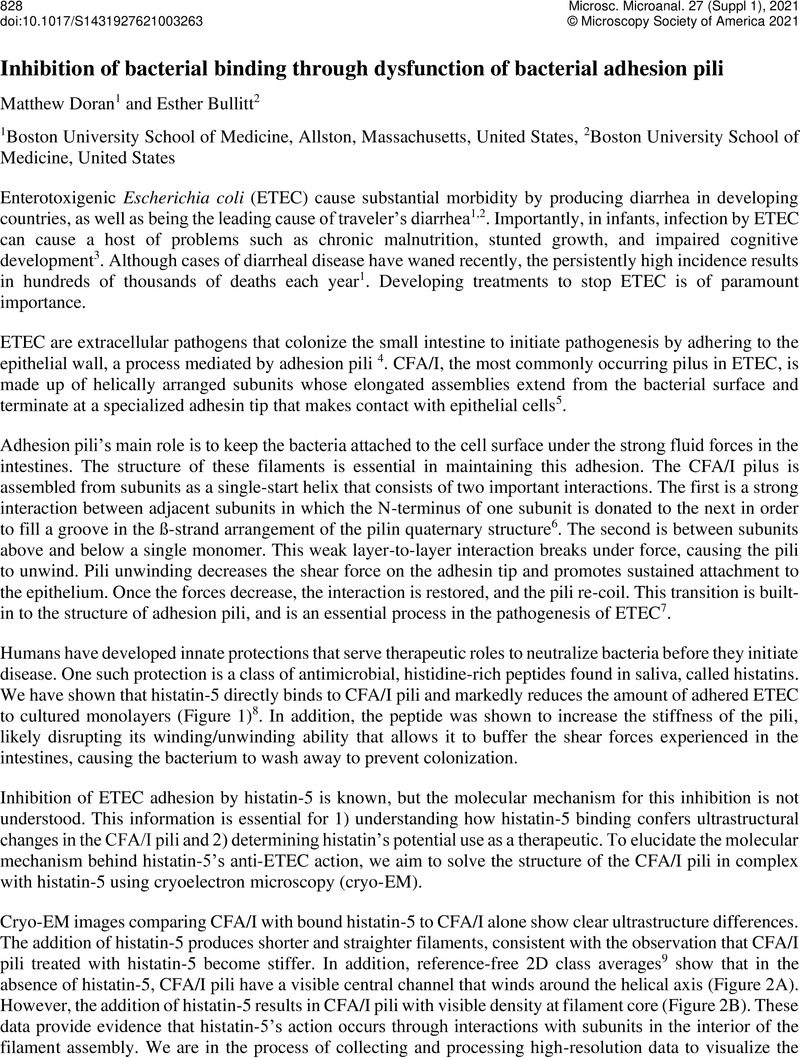No CrossRef data available.
Article contents
Inhibition of bacterial binding through dysfunction of bacterial adhesion pili
Published online by Cambridge University Press: 30 July 2021
Abstract
An abstract is not available for this content so a preview has been provided. As you have access to this content, a full PDF is available via the ‘Save PDF’ action button.

- Type
- 3D Structures: From Macromolecular Assemblies to Whole Cells (3DEM FIG)
- Information
- Copyright
- Copyright © The Author(s), 2021. Published by Cambridge University Press on behalf of the Microscopy Society of America
References
Qadri, F., Svennerholm, A.-M., Faruque, A. S. G. & Sack, R. B. Enterotoxigenic Escherichia coli in developing countries: epidemiology, microbiology, clinical features, treatment, and prevention. Clin. Microbiol. Rev. 18, 465–483 (2005).CrossRefGoogle ScholarPubMed
Shah, N., DuPont, H. L. & Ramsey, D. J. Global etiology of travelers’ diarrhea: systematic review from 1973 to the present. Am. J. Trop. Med. Hyg. 80, 609–614 (2009).CrossRefGoogle ScholarPubMed
Checkley, W. et al. Multi-country analysis of the effects of diarrhoea on childhood stunting. Int. J. Epidemiol. 37, 816–830 (2008).CrossRefGoogle ScholarPubMed
Satterwhite, T. K., Evans, D. G., DuPont, H. L. & Evans, D. J. Role of Escherichia coli colonisation factor antigen in acute diarrhoea. Lancet Lond. Engl. 2, 181–184 (1978).Google ScholarPubMed
Sakellaris, H., Munson, G. P. & Scott, J. R. A conserved residue in the tip proteins of CS1 and CFA/I pili of enterotoxigenic Escherichia coli that is essential for adherence. Proc. Natl. Acad. Sci. U. S. A. 96, 12828–12832 (1999).CrossRefGoogle ScholarPubMed
Zheng, W., Andersson, M., Mortezaei, N., Bullitt, E. & Egelman, E. Cryo-EM structure of the CFA/I pilus rod. IUCrJ 6, 815–821 (2019).Google ScholarPubMed
Baker, J. L., Dahlberg, T., Bullitt, E. & Andersson, M. Impact of an alpha helix and a cysteine-cysteine disulfide bond on the resistance of bacterial adhesion pili to stress. bioRxiv 2021. 01.18.427124 (2021).Google Scholar
Brown, J. W. et al. A Role for Salivary Peptides in the Innate Defense Against Enterotoxigenic Escherichia coli. J. Infect. Dis. 217, 1435–1441 (2018).CrossRefGoogle ScholarPubMed
Zivanov, J. et al. New tools for automated high-resolution cryo-EM structure determination in RELION-3. eLife 7, e42166 (2018).Google ScholarPubMed
Desta, I. T., Porter, K. A., Xia, B., Kozakov, D. & Vajda, S. Performance and Its Limits in Rigid Body Protein-Protein Docking. Structure 28, 1071-1081.e3 (2020).CrossRefGoogle ScholarPubMed
Brewer, D., Hunter, H. & Lajoie, G. NMR studies of the antimicrobial salivary peptides histatin 3 and histatin 5 in aqueous and nonaqueous solutions. Biochem. Cell Biol. Biochim. Biol. Cell. 76, 247–256 (1998).CrossRefGoogle ScholarPubMed



